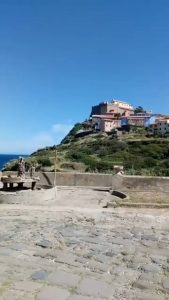 Ortigia is Siracusa’s downtown. While getting there, although no one notices it, you cross a 30 m-long bridge. Which undoubtedly makes Ortigia an island.
Ortigia is Siracusa’s downtown. While getting there, although no one notices it, you cross a 30 m-long bridge. Which undoubtedly makes Ortigia an island.
Ortigia is also the history of Siracusa. It was the most important Greek colony of all to the point that it won against its Greek “parents” in a historic war hundreds of years before christ. And the colony was born in Ortigia and not on the mainland.
By including it on my itinerary, I was wondering how much of an island Ortigia is today, and how much its inhabitants feel its island essence. Once again, two days are too few to understand this, but I had some clear proofs that a sense of insularity exists here too. They came from Massimo’s visible emotion when he was telling us about its daily crossing of the bridge to go to work to create charming jewels, some of which inspired directly by Ortigia’s Greek history. Or from the stories about the small town lifestyle from a late “ortigiana”, Tiziana, of the Enoteca “a putia” delle cose buone (where food is awesome and the atmosphere impressively nice).
I mean, there’d be a lot to say and investigate. But it’s not my purpose right now. All I know is that Ortigia is one of Italy’s most beautiful places, Piazza Minerva is in my opinion (and according to Emanuele Crialese too) the most beautiful square in Italy, but the cost of an apartment at the square meter is around 10 thousand euros, and so this balance already partially destabilized by an exorbitant amount of tourists is fragile and put at risk day by day. I wish there were more people like Paola, owner of a lovely B&B, a cozy woman, with so much desire to share and totally devoted to her Ortigia. Thank you so much, Paola…
Anyway. Now I set sail towards another atypical island, the historic centre of Gallipoli. To reach it, the longest leg so far awaits me: 240 miles of Ionian Sea.
Posted on: Leave a comment


